It is the third day of Cinefest, the 17th International Festival of German Film-Heritage in Hamburg. The theme of the festival is 'Cinema, War, and Tulips: German-Dutch Film Relations'. Hurrah! Ich lebe!/Hurray! I Live! (Wilhelm Thiele, 1928) is another German film that is situated in North Holland and was partially filmed in Rotterdam. The star of the film is Nicolas Koline (1878-1973), one of the Russian actors who fled from the country after the revolution. He played in several French and German films directed by Russian emigré directors.

German film magazine Illustrierter Film-Kurier, 1928. Cover of a special issue on Hurra, ich lebe! (Wilhelm Thiele, 1928).
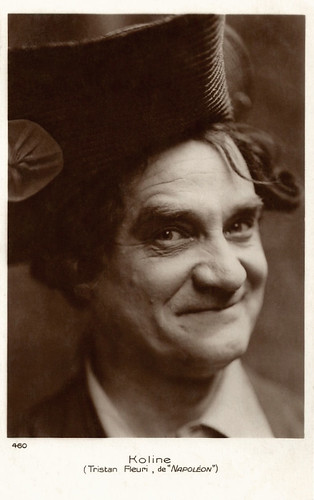
French postcard by Editions Cinémagazine, no. 460. Photo: Nicolas Koline as Tristan Fleuri in Napoléon (Abel Gance, 1927).
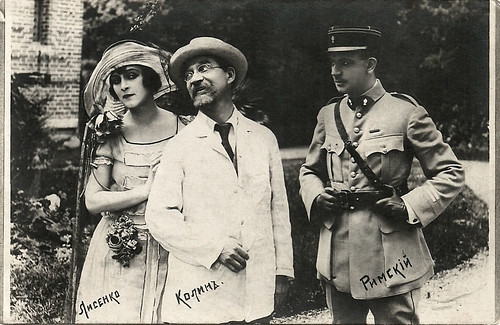
French postcard, with names written in Russian. The Russian actors Nathalie Lissenko, Nicolas Koline, and Nicolas Rimsky in the Albatros production Calvaire d'amour (Viktor Tourjansky, 1923).
Nicolas Koline was born Nikola Fjodorowitsch Kolin in St. Petersburg, Russia in 1878. He first got an education as a teacher before he decided at the age of 29 to become an actor.
He established himself in Russia as a stage performer with the Moscow Art Theatre. Koline was one of the Russian actors fleeing from the country after the revolution and during the Civil War. He went to France with La Chauve-Souris cabaret run by Nikita Balieff.
There he played in several films directed by Russian emigré directors. The first was L'angoissante aventure/Agonizing Adventure (Yakov Protazanov, 1920), a film with several fled Russian actors: Ivan Mozzhukhin (the lead and the scriptwriter of the film, together with Alexander Volkov), Nathalie Lissenko, Dimitri Buchowetzki, Vera Orlova, and Nicolas Panoff.
The film was started during the trip of the emigrés from Yalta to Paris and finished in the Montreuil studio in Paris. It was the second film of the Ermolieff company, which a few years after turned into Albatros Films.
The newly formed company Ermolieff Films (1920) gathered Russian emigrés; this also included Russian cameramen such as Fédote Bourgassoff and Nicolas Toporkoff.
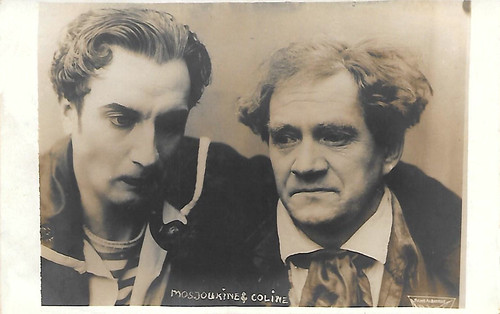
Vintage postcard. Photo: Films Albatross. Nicolas Koline and Ivan Mozzhukhin. Collection: Didier Hanson.

British postcard by the Embassy Theatre. Photo: Films Albatross. Nicolas Koline and Ivan Mozzhukhin in Kean/Edmund Kean: Prince Among Lovers (Alexander Volkov, 1924). In Great Britain, the film was distributed By Pinnacle Productions Ltd. and titled Kean - The Madness of Genius.

German postcard. Photo: Nicolas Koline in Kean/Edmund Kean: Prince Among Lovers (Alexander Volkov, 1924).
After this first film, Nicolas Koline appeared in La tourmente/The Storm (Serge Nadejdine, 1921), Justice d'abord/Justice at First (Yakov Protazanov, 1921), and Les Contes de mille et une nuits/The Tales of a Thousand and One Nights (Viatcheslav/Victor/Viktor Tourjansky, 1921).
Koline appeared in the serial La maison du mystère/The House of Mystery (Alexander Volkov, 1922) which was also released as a feature; Nuit de carnaval (Viktor Tourjansky, 1922), and Calvaire d'amour/Ordeal of Love (Viktor Tourjansky, 1923).
He had leading parts in Le brasier ardent/The Burning Brazier (Ivan Mozzhukin, Alexander Volkov, 1923), Le Chant de l'amour triomphant/The Triumphant Love Song (Viktor Tourjansky, 1923), and Kean/Edmund Kean: Prince Among Lovers (Alexander Volkov, 1923) starring Ivan Mozzhukhin.
Koline was even the main star of Le Chiffonnier de Paris/The Ragman of Paris (Serge Nadejdine, 1924), after the famous drama by Félix Pyat.
In the same year, he played leading roles opposite Nathalie Kovanko and Nicolas Rimsky in La Dame masquée/The Masked Lady (Viktor Tourjansky, 1924) and opposite Andrée Brabant and again Rimsky in La Cible/The Target (Serge Nadejdine, 1924).

French postcard by Cinémagazine Editions, no. 135.

Vintage postcard.
Nicolas Koline reunited with Ivan Mozzhukhin in the French silent historical adventure film Michel Strogoff (Victor Tourjansky, 1926). He then co-directed the silent comedy 600,000 francs par mois/600,000 Francs a Month (Nicolas Koline, Robert Péguy, 1926) in which he co-starred with Charles Vanel. He played Tristan Fleuri in the epic Napoléon (Abel Gance, 1927), which tells the story of Napoleon's early years. He co-starred with Betty Balfour and Walter Byron in Croquette (Louis Mercanton, 1927).
In the late 1920s, Nicolas Koline started to play in German films by the Ufa. First, he appeared in the Franco-German co-production Die geheimnisse des Orients/The Secrets of the Orient (Alexander Volkov, 1928), a film with an international cast including Hungarian Ivan Petrovich, Italian Marcella Albani, and French Gaston Modot.
It was followed by Hurrah! Ich lebe!/Hurray! I Live! (Wilhelm Thiele, 1928) where Koline played opposite his compatriot Natalia Lissenko, and Gaukler/Les saltimbanques (1929/1930), a multilingual directed by Robert Land in the German version and by Jacquelux in the French version.
From 1934 on, Nicolas Koline played minor parts in German films such as the coproduction Variétés/Vaudevilles (Nicolas Farkas, 1935) with Annabella, Menschen ohne Vaterland/People Without Fatherland (Herbert Maisch, 1936) with Willy Fritsch, Patrioten/Patriots (Karl Ritter, 1937) with Lida Baarova, and Ab Mitternacht/From Midnight (Carl Hoffmann, 1938) with Gina Falckenberg.
He also made several films directed by Victor Tourjansky: Geheimzeichen LB17/Secret Sign LB17 (1938), Der Gouverneur/The Governor (1939), Feinde/Enemies (1940), and in particular Illusion (1941) with Johannes Heesters and Brigitte Horney, and Tonelli (1943) with Ferdinand Marian and Winnie Markus.

German postcard by Ross Verlag, Berlin, no. 1063/1, 1927-1928. Photo: DeWesti Film-Verleih.

German postcard by Ross Verlag, Berlin, no. 3709/1, 1928-1929. Photo: Ufa.
Nikolas Koline had one major part in the war years, in Johann (Robert A. Stemmle, 1943). He also played several small roles until the end of the decade.
He appeared in films by a.o. G.W. Pabst and Hans Steinhoff such as Komödianten/The Comedians (1941) and Rembrandt (1942).
After the war, Koline remained in Germany and played small parts in films from 1947 on again, but in 1948 he also had a major lead again in Tragödie einer Leidenschaft/Tragedy of a Passion by Kurt Meisel, an adaptation of the Nikolai Leskov novel.
Koline continued to play in German films until he died in 1954. He usually played small parts but occasionally a bigger one as in Cuba Cabana (Fritz Peter Buch, 1952), starring Zarah Leander.
Some of Koline's parts were again in films by Tourjansky, such as Dreimal Komödie/Three Times Comedy (1949), Der blaue Strohhut/The Blue Straw Hat (1949) and Salto mortale (1953). In 1956, Nicolas Koline left for the United States, where he lived in poverty. He died in 1973 in Nyack, New York, at the age of 95.
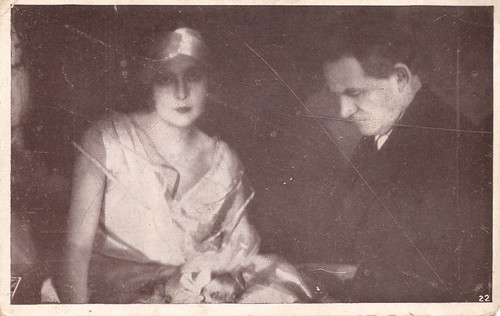

Belgian postcard. Verso. Publicity postcard for the screening of the Albatros production La dame masquée (Viktor Tourjansky, 1924) at the Brussels Ciné Palladium, from 12 to 18 September 1924. Palladium was a Brussels cinema on the Rue Neuve No. 35. It opened in 1920 and probably closed in 1954, at the opening of its neighbour on no. 37, cinema Astor.
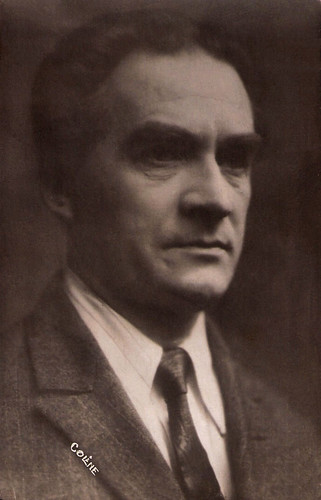
French postcard.
Sources: François Albéra (Albatros - des Russes à Paris 1919-1929), Filmportal, Find A Grave, Wikipedia and IMDb.
This post was last updated on 30 December 2024.

German film magazine Illustrierter Film-Kurier, 1928. Cover of a special issue on Hurra, ich lebe! (Wilhelm Thiele, 1928).

French postcard by Editions Cinémagazine, no. 460. Photo: Nicolas Koline as Tristan Fleuri in Napoléon (Abel Gance, 1927).

French postcard, with names written in Russian. The Russian actors Nathalie Lissenko, Nicolas Koline, and Nicolas Rimsky in the Albatros production Calvaire d'amour (Viktor Tourjansky, 1923).
Between Yalta and Paris
Nicolas Koline was born Nikola Fjodorowitsch Kolin in St. Petersburg, Russia in 1878. He first got an education as a teacher before he decided at the age of 29 to become an actor.
He established himself in Russia as a stage performer with the Moscow Art Theatre. Koline was one of the Russian actors fleeing from the country after the revolution and during the Civil War. He went to France with La Chauve-Souris cabaret run by Nikita Balieff.
There he played in several films directed by Russian emigré directors. The first was L'angoissante aventure/Agonizing Adventure (Yakov Protazanov, 1920), a film with several fled Russian actors: Ivan Mozzhukhin (the lead and the scriptwriter of the film, together with Alexander Volkov), Nathalie Lissenko, Dimitri Buchowetzki, Vera Orlova, and Nicolas Panoff.
The film was started during the trip of the emigrés from Yalta to Paris and finished in the Montreuil studio in Paris. It was the second film of the Ermolieff company, which a few years after turned into Albatros Films.
The newly formed company Ermolieff Films (1920) gathered Russian emigrés; this also included Russian cameramen such as Fédote Bourgassoff and Nicolas Toporkoff.

Vintage postcard. Photo: Films Albatross. Nicolas Koline and Ivan Mozzhukhin. Collection: Didier Hanson.

British postcard by the Embassy Theatre. Photo: Films Albatross. Nicolas Koline and Ivan Mozzhukhin in Kean/Edmund Kean: Prince Among Lovers (Alexander Volkov, 1924). In Great Britain, the film was distributed By Pinnacle Productions Ltd. and titled Kean - The Madness of Genius.

German postcard. Photo: Nicolas Koline in Kean/Edmund Kean: Prince Among Lovers (Alexander Volkov, 1924).
Leading parts
After this first film, Nicolas Koline appeared in La tourmente/The Storm (Serge Nadejdine, 1921), Justice d'abord/Justice at First (Yakov Protazanov, 1921), and Les Contes de mille et une nuits/The Tales of a Thousand and One Nights (Viatcheslav/Victor/Viktor Tourjansky, 1921).
Koline appeared in the serial La maison du mystère/The House of Mystery (Alexander Volkov, 1922) which was also released as a feature; Nuit de carnaval (Viktor Tourjansky, 1922), and Calvaire d'amour/Ordeal of Love (Viktor Tourjansky, 1923).
He had leading parts in Le brasier ardent/The Burning Brazier (Ivan Mozzhukin, Alexander Volkov, 1923), Le Chant de l'amour triomphant/The Triumphant Love Song (Viktor Tourjansky, 1923), and Kean/Edmund Kean: Prince Among Lovers (Alexander Volkov, 1923) starring Ivan Mozzhukhin.
Koline was even the main star of Le Chiffonnier de Paris/The Ragman of Paris (Serge Nadejdine, 1924), after the famous drama by Félix Pyat.
In the same year, he played leading roles opposite Nathalie Kovanko and Nicolas Rimsky in La Dame masquée/The Masked Lady (Viktor Tourjansky, 1924) and opposite Andrée Brabant and again Rimsky in La Cible/The Target (Serge Nadejdine, 1924).

French postcard by Cinémagazine Editions, no. 135.

Vintage postcard.
Ufa
Nicolas Koline reunited with Ivan Mozzhukhin in the French silent historical adventure film Michel Strogoff (Victor Tourjansky, 1926). He then co-directed the silent comedy 600,000 francs par mois/600,000 Francs a Month (Nicolas Koline, Robert Péguy, 1926) in which he co-starred with Charles Vanel. He played Tristan Fleuri in the epic Napoléon (Abel Gance, 1927), which tells the story of Napoleon's early years. He co-starred with Betty Balfour and Walter Byron in Croquette (Louis Mercanton, 1927).
In the late 1920s, Nicolas Koline started to play in German films by the Ufa. First, he appeared in the Franco-German co-production Die geheimnisse des Orients/The Secrets of the Orient (Alexander Volkov, 1928), a film with an international cast including Hungarian Ivan Petrovich, Italian Marcella Albani, and French Gaston Modot.
It was followed by Hurrah! Ich lebe!/Hurray! I Live! (Wilhelm Thiele, 1928) where Koline played opposite his compatriot Natalia Lissenko, and Gaukler/Les saltimbanques (1929/1930), a multilingual directed by Robert Land in the German version and by Jacquelux in the French version.
From 1934 on, Nicolas Koline played minor parts in German films such as the coproduction Variétés/Vaudevilles (Nicolas Farkas, 1935) with Annabella, Menschen ohne Vaterland/People Without Fatherland (Herbert Maisch, 1936) with Willy Fritsch, Patrioten/Patriots (Karl Ritter, 1937) with Lida Baarova, and Ab Mitternacht/From Midnight (Carl Hoffmann, 1938) with Gina Falckenberg.
He also made several films directed by Victor Tourjansky: Geheimzeichen LB17/Secret Sign LB17 (1938), Der Gouverneur/The Governor (1939), Feinde/Enemies (1940), and in particular Illusion (1941) with Johannes Heesters and Brigitte Horney, and Tonelli (1943) with Ferdinand Marian and Winnie Markus.

German postcard by Ross Verlag, Berlin, no. 1063/1, 1927-1928. Photo: DeWesti Film-Verleih.

German postcard by Ross Verlag, Berlin, no. 3709/1, 1928-1929. Photo: Ufa.
Zarah Leander
Nikolas Koline had one major part in the war years, in Johann (Robert A. Stemmle, 1943). He also played several small roles until the end of the decade.
He appeared in films by a.o. G.W. Pabst and Hans Steinhoff such as Komödianten/The Comedians (1941) and Rembrandt (1942).
After the war, Koline remained in Germany and played small parts in films from 1947 on again, but in 1948 he also had a major lead again in Tragödie einer Leidenschaft/Tragedy of a Passion by Kurt Meisel, an adaptation of the Nikolai Leskov novel.
Koline continued to play in German films until he died in 1954. He usually played small parts but occasionally a bigger one as in Cuba Cabana (Fritz Peter Buch, 1952), starring Zarah Leander.
Some of Koline's parts were again in films by Tourjansky, such as Dreimal Komödie/Three Times Comedy (1949), Der blaue Strohhut/The Blue Straw Hat (1949) and Salto mortale (1953). In 1956, Nicolas Koline left for the United States, where he lived in poverty. He died in 1973 in Nyack, New York, at the age of 95.


Belgian postcard. Verso. Publicity postcard for the screening of the Albatros production La dame masquée (Viktor Tourjansky, 1924) at the Brussels Ciné Palladium, from 12 to 18 September 1924. Palladium was a Brussels cinema on the Rue Neuve No. 35. It opened in 1920 and probably closed in 1954, at the opening of its neighbour on no. 37, cinema Astor.

French postcard.
Sources: François Albéra (Albatros - des Russes à Paris 1919-1929), Filmportal, Find A Grave, Wikipedia and IMDb.
This post was last updated on 30 December 2024.
No comments:
Post a Comment